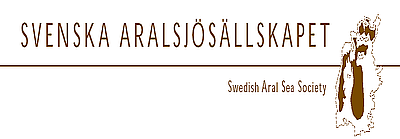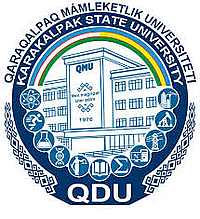Swedish Aral Sea Society
Några fakta om Aralsjöregionen och Centralasien
- Regionen blir allt intressantare geopolitiskt. Ryssland, Kina, USA, Europa och i viss mån Turkiet vill ha inflytande. Kina långt framme med investeringar i flera av länderna. Investeringar i Sidenvägen (Belt and road) med det långsiktiga målet att har snabbare transporter till Europa är ett fokus.
- Med den nya presidenten i Uzbekistan har de fem länderna kommit varandra politiskt närmare. Det praktiska samarbetet kunde dock vara betydligt bättre utvecklat
- I regionen talar man gärna om hållbar utveckling, förnybara energikällor mm. Men Uzbekistan använder fortfarande enormt mycket vatten för bevattning och Kazakstan är en av de länder i världen som har mest CO2-utsläpp per capita.
Negativ utveckling
Vattnet från Amu Darya och Syr Darya används i stort sett upp helt och hållet på väg till den uttorkade Aralsjön och:
- Klimatförändringarna kan påverka detta ytterligare negativt.
- Hastigt ökande befolkning.
- Afghanistan har börjat ta betydande mängder av vatten uppströms i Amu Darya.
Positiva tendenser
- Uzbekistan och Kazakstan satsar på att få en effektivare vattenanvändning genom att minska förlusterna innan vattnet kommer fram till fälten och på att använda en bättre bevattningsteknologi som t ex droppbevattning.
- Samma länder anstränger sig också för att plantera buskar och träd på den torra botten av Aralsjön som annars är en källa för ”dust storms”.
- Energi/vatten-samarbetet mellan uppströms och nedströms-länderna har förbättrats. T ex byter Kirgizistan energi från Kazakstan under vintern mot att de sparar vatten i reservoarer så att detta kan användas för bevattning under vegetationsperioden.
- Norra Aralsjön är relativt stabil och har en rimlig ekologisk situation.

Welcome to the Swedish Aral Sea Society!
25 years with the Swedish Aral Sea Society
Sustainable Development and Sustainability Science Course
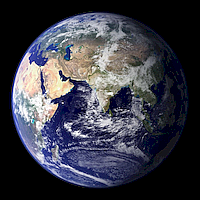 The Master of Science level academic course Sustainable Development and Sustainability Science (SDSS) starts the 19 February 2025.
The Master of Science level academic course Sustainable Development and Sustainability Science (SDSS) starts the 19 February 2025.
The online course has been developed by the Swedish Aral Sea Society in cooperation with Uzbek academic research colleagues and gives an overarching introduction to the Sustainable Development challenges and a scientific view on how to approach them.
The International Students Conference planned for the 7 April is delayed. Final date will be decided later.
The latest lecture:
Lecture 11, part I: A Culture of Mobility and Means of Mobility - Frostell (mp4)
Lecture 11, part I: A Culture of Mobility and Means of Mobility - Frostell (pdf)
Lecture 11, part II: A Culture of Mobility and Means of Mobility - Oripov (mp4)
See the page Lectures and Presentations 2025 for previous lectures.
SASS celebrates 25 years, 2025, with two meetings.
On February 12 at 18.00 members and other interested parties met for a meeting and lectures at the School of Economics, Sveavägen 65, Stockholm.
January 23 an online conference on Implementing Education for Sustainable Development in Higher Education” was arranged.
Information and presentations from the conference are available at the Conference Materials page.
Join Us!
More members mean more possibilities
Become a member of the Swedish Aral Sea Society now or renew your membership. The membership fee for 2025 is SEK 200 and is paid into Plusgiro 354165-3. Don't forget to state your name and preferably also your e-mail address as a message from your internet bank or on the payment card.
The Aral Sea
The drying up of the Aral Sea is a monumental killing blow to nature, caused by man and a predatory exploitation of limited water resources in Central Asia. The Swedish Aral Sea Society (SASS) works to spread information about the Aral Sea and the environmental disaster and work for democracy and development in the area.
Today, the lake is divided into several smaller lakes. Only the northernmost "Lesser Aral Sea" now has water inflow and can again produce fish. The other lakes have such a high salt content that they cannot contain any life. The situation for the people and animal species that live around the former Aral Sea shores is getting worse. Many of us have seen the strange and scary pictures of big fishing boats that have stranded and remained in a huge sand desert. The human tragedies that follow in the wake of the disaster have not been shown as clearly. Unemployment, poverty, and disease have taken over in the former booming coastal landscapes. Large amounts of dried salt, fertilizer, and pesticides that have accumulated over numerous decades today are spreading with the wind and thus poisoning the soil, the air, and the groundwater. Fishing has disappeared, factories have been shut down, schools and health care have been depleted.
We do not yet know the full range of damages to the ecosystem or the effects they have on food, drinking water and the spread of diseases that follow in the path of poverty and environmental degradation. Women and children are the hardest hit. Child mortality is among the highest in the former Soviet Union. Few children are born today completely healthy and well-made. Virtually all toddlers are anaemic. Anaemia is also common in pregnant women, and therefore childbirth is often complicated.
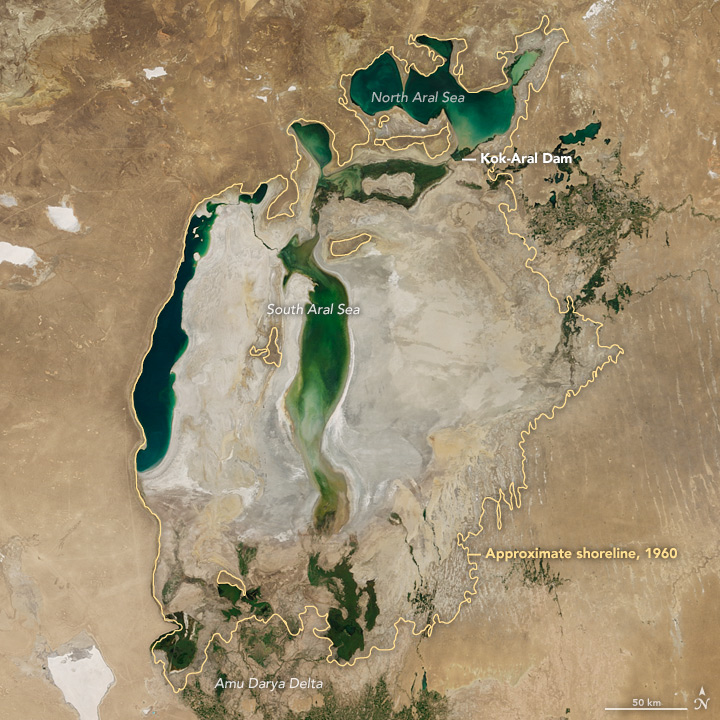
The Aral Sea in August 2017 compared with 1960.
Photo: NASA Earth Observatory image by Jesse Allen, using Terra MODIS data from the Land Atmosphere Near real-time Capability for EOS (LANCE) and Landsat data from the U.S. Geological Survey.
Join the SASS
The Swedish Aral Sea Society (SASS) is open also for international members. To join, pay the annual membership fee of SEK 200 to the Swedish Plusgiro 354165-3. Don't forget to write your name and email address on the invoice!
An Environmental Disaster
The desiccation of the Ara Sea is a monumental blow to nature, caused by man and an unhinged use of water resources in Central Asia. The Swedish Aral Sea Society aims at spreading information on one of the largest environmental disasters in the world.
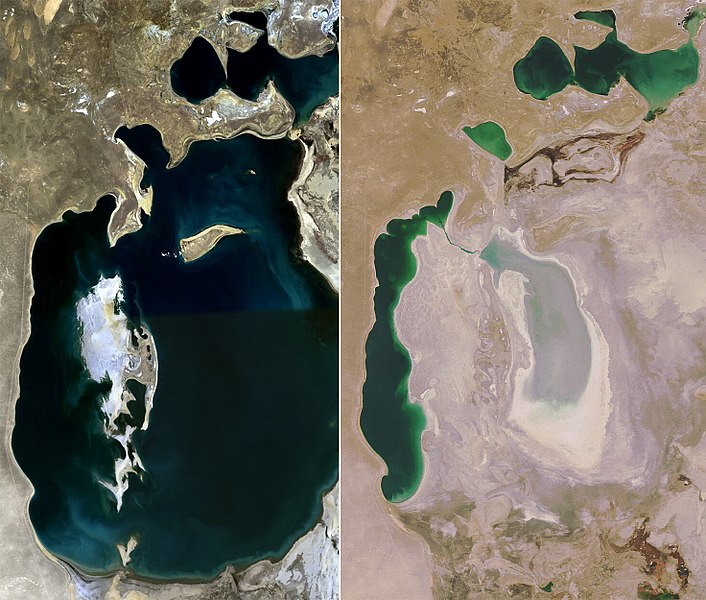 The Aral Sea in 1989 (left) and in 2008 (right). Satellite photo: NASA.
The Aral Sea in 1989 (left) and in 2008 (right). Satellite photo: NASA.
Until the 1960s, the Aral Sea was one of the largest lakes on our planet. It is located in western Central Asia, between Kazakhstan and Uzbekistan, and has a long history. 50 years ago, the Aral Sea was the fourth-largest lake on earth, 12 times the size of Lake Vänern. Since then, more than half of the lake's surface and more than two-thirds of its water have disappeared, leaving mile upon mile of desiccated, salt-laden lake bed. This is because large-scale cotton cultivation with huge irrigation facilities was forced upon the Soviet Union to become self-sufficient in cotton. The water was taken from the two rivers that flow into the Aral Sea, where originally 1/3 of the water came from the Syr Darya River and 2/3 from the Amu Darya. Through the systematic diversion of the rivers' water to extremely inefficient irrigation facilities, the Aral Sea lost almost its entire water supply (98%). This led to the rapid drying up of the Aral Sea.
Today, the lake is divided into five smaller lakes. Only the northernmost "Little Aral Sea" now receives water and can once again produce fish. The other lakes have such a high salt content that they cannot contain any life. The situation for the people and animal species that live around the former Aral Sea beaches is getting worse. The five lakes continue to dry up. Many of us have seen the strange and terrifying images of large fishing boats stranded and left in a vast sand desert. The human tragedies that follow in the wake of the disaster have not been shown as clearly. Unemployment, poverty and disease have taken over the once prosperous coastal landscapes. Large amounts of dried salt, fertilizers and pesticides that have accumulated over several decades are today spread with the wind and have thus poisoned the soil, air and groundwater. Fishing has disappeared, factories have closed down, schools and healthcare have been impoverished.
We do not yet know the full extent of the damage to ecosystems or the effects they have had on food, drinking water and the spread of disease, which follows in the wake of poverty and environmental destruction. Women and children are hit hardest. Child mortality is among the highest in the entire former Soviet Union. Few children today are born completely healthy and well-formed. Virtually all young children are anaemic. Anaemia is also common in pregnant women and therefore births are often complicated.
The drying up of the Aral Sea is one of our times' bitterest killing blows against nature, caused by man himself. It shows painfully clearly the consequences of short-term attempts to exploit nature for economic gain. The decisions that led to the disaster must be replaced by decisions that return the inhabitants of the Aral Sea region to their health and opportunities to once again support themselves from the once productive ecosystems.
Our Background
The Swedish Aralsjösällskapet was formed from an informal network around the need to contribute to the work against the effects of a monumental waste of natural resources and environmental degradation in the Aral Sea region. The network was formed as a result of an international conference conducted in 1998 by the UN Development Fund for Women (UN Women Sweden, formerly Swedish Unifem) in collaboration with Save the Children and the Royal Swedish Academy of Sciences.
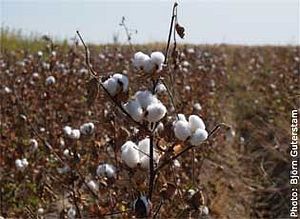 Among the activities that the Swedish Aral Sea Societe has arranged, often in collaboration with other important organizations, can be mentioned: sending out a number of young participants from Sweden to participate in a children's conference "Children, Citizenship and Environment" in Karakalpakstan 1999, international seminars during World Water Week in Stockholm; water presentation at the conference "Prospects of Democracy in Central Asia" in Istanbul 2003; cultural exchange with the region through a visit to Sweden by the head of the art museum in Nukus 2003; seminar on the theme "Children at Risk" with participation from the region 2005; seminar on democracy issues with the former British ambassador to Uzbekistan 2005 and seminar on oil and gas in Central Asia 2005. In the autumn of 2006, a conference was held with KVA with international participation under the title "Who speaks up for the Aral Sea? Central Asia in Crisis ”, from which was reported in the international scientific journal AMBIO.
Among the activities that the Swedish Aral Sea Societe has arranged, often in collaboration with other important organizations, can be mentioned: sending out a number of young participants from Sweden to participate in a children's conference "Children, Citizenship and Environment" in Karakalpakstan 1999, international seminars during World Water Week in Stockholm; water presentation at the conference "Prospects of Democracy in Central Asia" in Istanbul 2003; cultural exchange with the region through a visit to Sweden by the head of the art museum in Nukus 2003; seminar on the theme "Children at Risk" with participation from the region 2005; seminar on democracy issues with the former British ambassador to Uzbekistan 2005 and seminar on oil and gas in Central Asia 2005. In the autumn of 2006, a conference was held with KVA with international participation under the title "Who speaks up for the Aral Sea? Central Asia in Crisis ”, from which was reported in the international scientific journal AMBIO.
Page 1 of 15
